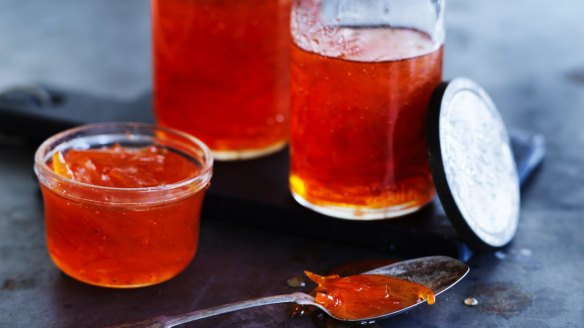How to make marmalade

Every year for the past decade I've been getting out my marmalade spoon to judge The World Marmalade Awards in England's Cumbria. Jars get flown over from home cooks and small producers around the world, all hoping to snatch the World's Best Marmalade title. Australian cooks win often, with perfectly set jars punchy with citrus flavour, and one reason is that many of us have citrus trees in our gardens. So if you've never made marmalade, you can start today, and eat it this weekend with great straightforward homemade crumpets. Here are my marmalade perfection points:
■ Soaking the peels overnight in water acidified with lemon and grapefruit juice breaks down the structure of the pith and pips slightly, releasing pectin into the water and giving you a better set.
■ Testing for pectin: put a teaspoonful of marmalade cooking liquid in a cup and pouring on roughly the same amount of methylated spirits. If the cooking liquid forms a gel clump in the cup, the pectin is fine. If it doesn't, reduce the cooking liquid in the saucepan and test again until it does. Don't drink the liquid: meths is alcohol with added chemicals to make it toxic. Throw it away after testing.
■ Test for acidity: the cooking liquid should taste mildly but clearly acidic with lemon. But to double-check, stick in a strip of 1-14 pH testing strips (order through eBay). You're looking for an acidity reading of around 2.8-3.2. When marmalade doesn't set, the culprit is often low acidity, so you can sometimes warm the marmalade, check and adjust the acidity by adding more lemon juice and reboil it to 104C.
■ Leave the peel overnight once you've added the sugar and heated the mixture to a bare simmer. This technique causes the peel to draw in sugar syrup, making it very tender and also giving it a similar specific gravity to the syrup so the peel will suspend evenly in the jar.
■ You'll need a thermometer to ensure the marmalade reaches the setting point, 104C. The temperature relates to the ratio of sugar to water in the pan – the higher the temperature, the higher the concentration of sugar in it – so reducing the sugar in the recipe won't produce a low-sugar marmalade but instead increases the concentration of pectin and acidity in the syrup once heated to 104C.
■ When you followed all the steps above correctly, the syrup will be surprisingly liquid, rather than jammy, when boiling. It will set as it cools in the jar so don't expect it to look like warmed jam in the pan. The magic happens as it cools.
The best recipes from Australia's leading chefs straight to your inbox.
Sign up